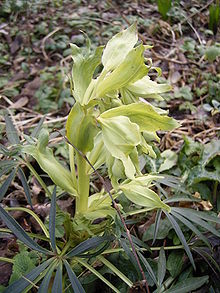Helleborus foetidus
| Helleborus foetidus | |
|---|---|
 |
|
| Scientific classification | |
| Kingdom: | Plantae |
| (unranked): | Angiosperms |
| (unranked): | Eudicots |
| Order: | Ranunculales |
| Family: | Ranunculaceae |
| Genus: | Helleborus |
| Species: | H. foetidus |
| Binomial name | |
|
Helleborus foetidus L. |
|
Helleborus foetidus, known variously as stinking hellebore /ˈhɛlɪbɔːr/, dungwort, setterwort and bear's foot, is a species of flowering plant in the buttercup family Ranunculaceae, native to the mountainous regions of Central and Southern Europe, Greece and Asia Minor. It is found wild in many parts of England, especially on limestone soil.
It is an evergreen perennial growing to 80 cm (31 in) tall and 100 cm (39 in) across, with a thick succulent stem and glossy leaves. The drooping cup-shaped flowers appear in spring, and are yellowish-green, often with a purple edge to the five petal-like sepals on strongly upright stems. The flowers, typically for the family, contain numerous stamens as well as up to ten nectaries which make them attractive to bees and other insects. Each flower produces up to five (usually three) wrinkled follicles. Despite its common name, it is not noticeably malodorous, although the foliage is pungent when crushed.
All parts of the plant are poisonous, containing glycosides. Symptoms of intoxication include violent vomiting and delirium.
Yeasts colonise the nectaries of stinking hellebore and their presence has been found to raise the temperature of the flower, which may aid in attracting pollinators to the flower by increasing the evaporation of volatile organic compounds. It was the first species in which this effect was discovered.
...
Wikipedia
